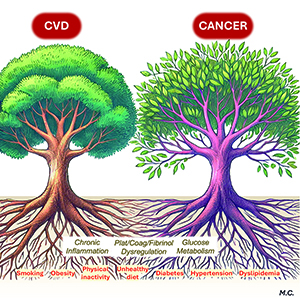Risk of recurrent venous thromboembolism in cancer patients after discontinuation of anticoagulant therapy

Submitted: 2 February 2024
Accepted: 24 February 2024
Published: 16 May 2024
Accepted: 24 February 2024
Abstract Views: 481
PDF: 187
Publisher's note
All claims expressed in this article are solely those of the authors and do not necessarily represent those of their affiliated organizations, or those of the publisher, the editors and the reviewers. Any product that may be evaluated in this article or claim that may be made by its manufacturer is not guaranteed or endorsed by the publisher.
All claims expressed in this article are solely those of the authors and do not necessarily represent those of their affiliated organizations, or those of the publisher, the editors and the reviewers. Any product that may be evaluated in this article or claim that may be made by its manufacturer is not guaranteed or endorsed by the publisher.
Similar Articles
- Rossella Marcucci, Rosanna Abbate, What is the gender of thrombosis? A natural model of precision medicine , Bleeding, Thrombosis and Vascular Biology: Vol. 2 No. 3 (2023)
- Luca D'Ambrosio, Maurizio Forte, Giacomo Frati, Sebastiano Sciarretta, Role of platelet autophagy in cardiovascular diseases , Bleeding, Thrombosis and Vascular Biology: Vol. 3 No. 2 (2024)
- Giovanni de Gaetano, Welcome to AICE and sincere wishes for peace for the new year 2024 , Bleeding, Thrombosis and Vascular Biology: Vol. 2 No. 4 (2023)
- Tiziano Barbui, Clonal hematopoiesis and inflammation: a link with thrombosis and malignancy , Bleeding, Thrombosis and Vascular Biology: Vol. 1 No. 2 (2022)
- Ottavia Borghese, Claudio Vincenzoni, Commentary on “Preventive percutaneous coronary intervention versus optimal medical therapy alone for the treatment of vulnerable atherosclerotic coronary plaques (PREVENT): a multicenter, open-label, randomized controlled trial” , Bleeding, Thrombosis and Vascular Biology: Vol. 3 No. 2 (2024)
- Paola Binetti, Thrombotic thrombocytopenic purpura: much done, but still a lot to do , Bleeding, Thrombosis and Vascular Biology: Vol. 3 No. 2 (2024)
- Coenraad H. Hemker, The clinical usefulness of measuring thrombin generation , Bleeding, Thrombosis and Vascular Biology: Vol. 2 No. 1 (2023)
- Luca Puccetti, Vincenzo Sammartano, Federico Caroni, Margherita Malchiodi, Paola Calzoni, Eleonora Franceschini, Lucrezia Galasso, Monica Bocchia, Safety of COVID-19 mRNA vaccination in patients with history of acquired hemophilia A: a case series , Bleeding, Thrombosis and Vascular Biology: Vol. 1 No. 3 (2022)
- Robert Parambi, Nicole Ziliotto, Francesco Bernardi , Marcello Baroni , Richard W Browne , Dejan Jakimovski, Bianca Weinstock-Guttman, Robert Zivadinov, Murali Ramanathan, Crosstalk between hemostasis inhibitors and cholesterol biomarkers in multiple sclerosis , Bleeding, Thrombosis and Vascular Biology: Vol. 1 No. 3 (2022)
- Cristina Santoro, Alessandro Casini, Addressing some challenges of congenital fibrinogen disorders in 2023 and beyond , Bleeding, Thrombosis and Vascular Biology: Vol. 2 No. 3 (2023)
You may also start an advanced similarity search for this article.

 https://doi.org/10.4081/btvb.2024.124
https://doi.org/10.4081/btvb.2024.124










